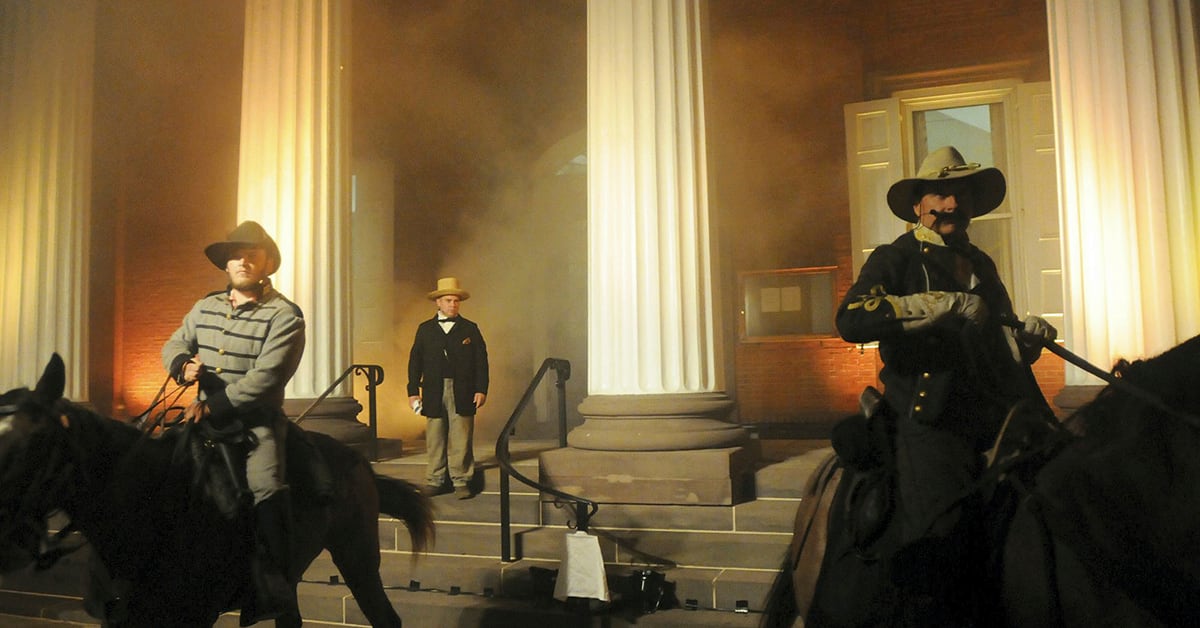CHAMBERSBURG, Pa. — The armies fighting the American Civil War scrapped civility in 1864 in the pastoral countryside of the Shenandoah and Cumberland valleys.
U.S. troops burned houses in Staunton, Virginia, then Confederates invading Pennsylvania burned Chambersburg.
The valleys, bread baskets for two warring armies, saw more destruction than almost anywhere else during the war, according to author Edward L. Ayers, president emeritus at the University of Richmond.
In his latest book, “The Thin Light of Freedom,” Ayers reveals the war through the people who lived in Augusta County in Virginia and Franklin County in Pennsylvania. The book grew out of his digital project, The Valley of the Shadow at the University of Virginia. It’s also a sequel to “In the Presence of Mine Enemies.”
About 44 percent of the white military-aged men in Franklin County joined the Union Army. In Augusta County 69 percent joined the Confederate army. Their families waited, sometimes with the war at their front doors.
Rumors swirled up and down the valley from June 1863 to April 1865. Who is winning the war? Where are the troops? How are our native sons?
Chambersburg’s two newspapers reported news from the front lines, but spun it to their own purposes. In 1864, The Franklin Repository, the predecessor of Public Opinion, backed Republican President Abe Lincoln. The Valley Spirit promoted the Democrats’ conspiracy theory that Lincoln kept the border unprotected so slavery would have to be destroyed and the Republicans remain in power.
In Staunton, Virginia, Joseph Waddell, like other white Southerners, wanted the two factions to tear the North apart. But as the war ended, he wrote in his diary: “To talk about re-union and contemplate it as an event about to occur, after all we have suffered, is almost intolerable, notwithstanding I never anticipated much good from the Confederacy.”
Ayers captures the ambivalence of citizens and soldiers throughout his book:
Jacob Christy, like other African American soldiers in the 54th Massachusetts, was waiting to be paid in early 1864. He wrote to his sister in Franklin County after the Battle of Olustee in Florida, “if we cant get our rights we will die trying for them We have been fighting as brave as ever thay was any soldiers fought I know if every regiment that are out there and have been out would have dun as well as we have the war would be over.”
Some Confederate soldiers anguished over the burning of Chambersburg homes on a sultry, calm July 30, 1864. Others justified burning the defenseless town “to protect their women” and in retribution for U.S. Gen. David Hunter’s burning of homes eight weeks earlier in the southern valley.
“I wanted to instill a sense of humility in our own lives,” Ayers said. “Let’s get over ourselves and let’s put us in the moment to realize what’s at stake.”
Chambersburg citizens treated the Confederates’ threat to burn the town as a joke, a Confederate soldier wrote after the war. He wanted them to take the soldiers seriously.
Citizens actually delayed responding to the Confederate demand for $100,000 in gold or $500,000 cash. They knew U.S. Gen. William Woods Averell was camped between Chambersburg and Greencastle, but his troops never arrived before the town was in flames.
“Whenever anything went wrong, it was assumed the general was drinking,” Ayers said. “People like to second guess generals a lot. We don’t have any way to know. It’s hard to understand why he didn’t come. The command structure was in disarray.”

Ayres also explores the politics of the times. The burning of Chambersburg all but spelled defeat for Lincoln in the election of 1864, then U.S. Gen. Philip Sheridan reorganized the Army of the Shenandoah and delivered victories in Virginia.
“Lincoln did not think in August that he was going to be re-elected,” Ayers said. “You can’t understand politics and military history divorced from each other.”
In “The Thin Line,” Ayers witnesses the Battle of Gettysburg and the Confederate retreat at a distance through the eyes and ears of Chambersburg and Staunton citizens. A Franklin Repository correspondent visited Gettysburg days after the battle. Confederate Brig. Gen. John D. Imboden, a native of Staunton, led miles of wagons full of soldiers wounded at Gettysburg over Pine Stump Road enroute to the Potomac River and Virginia.
Ayers said he does not know if Pine Stump Road has survived as a modern road.
“I feel chills when I come into Franklin County,” Ayers said. “I know it from the 19th century.”
He said he hopes his book will make Franklin County less familiar to the people who live here.
“It was quite interesting to see the continuities and discontinuities in your community in the 19th century,” he said.
The county not only embodies what the war was about, he said. It also was a witness to war.
Information from: Public Opinion, http://www.publicopiniononline.com




